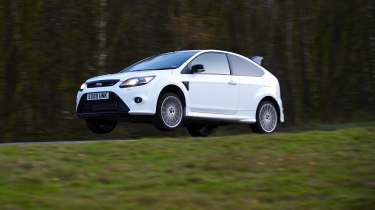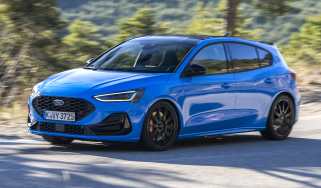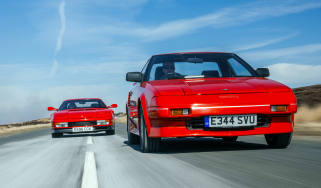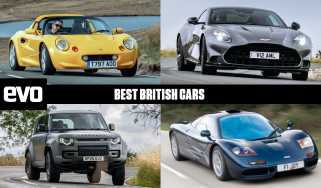Ford Focus RS v Renaultsport Megane 250 Cup v SEAT Leon Cupra R v VW Golf GTI
The ultimate hot hatch fight: the new Renault Megane 250 takes on Focus RS, Golf GTI and Cupra R
The Golf’s first to arrive. Whether it will also be first to finish is another matter altogether, but regardless of whether your perspective is shaped by history or simply a feeling that it looks like a punctual sort of car, VW’s GTI is a fitting first arrival. It sits outside the office, smartly turned out, but on this evidence (five-door, DSG, in grey, with a mobile phone cradle on the centre console) it’s got a long way to go to convince us that it’s desperate for victory. At the moment it looks desperate to get to Swindon for that crucial sales conference. Is it possible to spec a more sober-looking hot hatch?
Or a more aggressive one than a piercingly white Ford Focus RS? The hero car of 2009 is proof, if it were needed, that front-wheel drive is the new four-wheel drive and there’s no need to be afraid of a big bad wing. But here’s the thing: both of these cars are now part of the establishment. In terms of attitude, approach and potential audience, they bracket the class; none more sensible than the Golf, none more outrageous than the Focus.
Now two new cars are attempting to force themselves in between, and here’s the first, SEAT’s Leon Cupra R. Funny how the lairy green paint, so bold at our first drive in Barcelona, looks washed out in rain-lashed Northamptonshire, like it’s been coloured with a watery highlighter. Ten minutes later and, befitting our high expectations, a Renaultsport Mégane 250 Cup is discharged from a transporter, in it a sheet of paper that bears the words ‘Sender: S Marvin, Renaultsport Technologies’. That’ll be Stephen Marvin, deputy chief vehicle engineer. Looks like we’ve got the personal treatment.
More reviews
Group tests
In-depth reviews
Reviews
- Used Ford Focus ST Edition (Mk4, 2021 - 2025) review – a Honda Civic Type R rival for £20k
- Ford Focus 2025 review – is Ford killing its best car?
- Used Ford Focus RS500 (Mk2, 2010 - 2011): review, specs and buying guide for the original hyperhatch
- Used Ford Focus ST (Mk4, 2019 to date) review and buyer’s guide
A busy day lies ahead. We’re starting off at Rapid GB’s rolling road before moving on to the Bedford Autodrome and then the Millbrook Proving Ground. Tomorrow is Wales; today is a numbers day.
The first numbers are a bit bigger than expected. The damp, chill November air is just about ideal for peak dyno readings, and it turns out Renault could re-badge the Mégane a 270 (it produces 268bhp), while the Golf, over 10 per cent up on where it should be (229bhp rather than 207), is almost halfway to having the power promised for the forthcoming R version. The car that already has that new VW Group engine, the Cupra R, is also up a chunk from the 261bhp it’s meant to have, returning 274bhp. Is the dyno at fault? A 279bhp reading for the Focus suggests not – Rapid GB has yet to see an RS with a full 300-strong stable. The upshot of all this is that the 50bhp chasm that should separate Mégane from Focus is really only a 10bhp crack in the pavement. It should make for some interesting times at Bedford.
And it does. The Focus is slowest. But let’s be fair here – conditions on the patchily wet West Circuit are far from ideal, unfairly disadvantaging the early runners. But the Ford is actually its own worst enemy, seeming to suffer from fuel starvation in third gear through quick corners. Other RSs we’ve timed have managed sub-1:31.0 laps, but this one is nearly four seconds adrift.
Least fazed by the conditions is the Renault. It went out first, yet Roger Green came back praising its sure-footedness, traction and poise. Yet it couldn’t match the 1:32.2 lap of the fastest car out there, the Cupra R. The SEAT’s triumph comes as a surprise – it actually seems to roll more than the Golf and I’m still a long way from being convinced about the abilities of an electric faux diff. I suspect that a drier day would provide very different results.
A level playing field awaits at Millbrook. The levellest possible playing field in fact: the mile straight. It’s now dry, the timing gear is primed and I have John Barker in the passenger seat of the Mégane. We agree that it’s a nice place to spend time – provided you’re not subjected to life in the very dark rear compartment. The optional Recaros up front are superb and Renault has worked far harder than Ford to sort a snug driving position, the kind that tucks you down low and places the steering wheel exactly where you want it.
The gearchange is vastly improved over the old R26 Mégane’s. It still snags on the way into gears occasionally, the long lever seeming to flex slightly before it forces through a quick change, but even sitting on the wrong side of the car and forcing my right hand to make the unfamiliar movements, the tricky full-bore second-to-third shift slots home every time. But it’s the unseen parts of the drivetrain that impress more, a feeling that every last ounce of energy called on by the throttle is being transferred cleanly and effortlessly to the tarmac. There’s not even a suggestion of torque steer, just a focused lunge of acceleration and a mild roar of exhaust gas. The Focus RS is a wilder ride even in a straight line, spitting out noise, discharging its power in a more scattergun style. The end results are almost identical, though – only a tenth of a second separates them to both 60mph and the ton, the Ford just ahead with times of 6.0sec and 14.5sec respectively. But neither is as fast as the SEAT, which matches the Mégane to 60mph (6.1sec), but pulls out a half second advantage by the time it reaches the ton (14sec dead). The Golf, finger-snap DSG shifts keeping it in touch to 60mph (6.4sec), is 2.5sec adrift of the Leon by the time 100mph is breached. How this will all translate on the road we’ll find out tomorrow.
THE NEXT MORNING I bump into Henry Catchpole in the Mégane at Telford services. It’s not intentional since we’re rendezvousing in Bala, but my Leon needed fuel, Henry needed a quick kip and an old Cavalier needed a two-bloke bump-start, so it was just as well the fates collided. Good deed done, I leave Henry to his cosy Recaro and head on in the Leon, glad to get to some more interesting roads and leave the Cupra’s motorway tyre roar behind. It rides well, though. SEAT’s suspension tinkering has sorted the jarring crashiness that made previous Leons feel like they had wooden tyres. Speaking of wheels, I do fear for the longevity of these 19in rims. With their arching spokes protruding beyond the tyres, the result of kissing a kerb doesn’t bear thinking about.
We don’t have to worry about that out here, though. The Welsh borders are criss-crossed with interesting roads before you get to the more photogenic stuff further west. The Four Crosses route from Shrewsbury is a personal favourite and a good early testing ground for the Leon. There’s no denying it’s got a brilliant engine, the best here in fact, able to make the Focus feel slow on the uptake, the fast-spooling turbo providing searing mid-range delivery. It sounds great, too, the turbo’s hiss never allowed to overrule the zingy engine note. Progress is rapid and Bala heaves into view ahead of schedule.
Shame the engine is the best thing about the car. Where, for instance, is the front-end feel? After a while you learn to trust the tyres, but you can never truly commit to corners when the steering is providing you with so little and the comparatively soft suspension reports back so lazily about available grip. As far as communication goes, the Leon’s about as effective as a tin can and some string.
The rear axle is also at fault. It refuses to aid cornering angle, so besides steering input the only things that can alter the Leon’s trajectory are understeer and wheelspin. But the SEAT is swift, smooth and, despite the fact its ESP can’t be disabled, manages to pull itself out of corners effectively enough, so maybe we should cut it some slack. Or maybe we shouldn’t. That ‘R’ stands for the Racing version of the CUP RAcing model – it needs more edge if SEAT is to be taken seriously. The conclusion at the moment is that this car is a studious and obedient pupil of the VW school – it drives as if the thumbscrews have been applied.
This is confirmed when Henry pitches up, we switch places and I follow the Leon for a while. It just doesn’t look that interesting from behind and when we park up and discuss aesthetics it doesn’t hit the spot with either of us, the single- angle rise from bumper to roofline giving it the aura of an MPV. Not good. That said, I’m not as keen as Henry on the Mégane. Up close it’s all a bit hectic and the black 18in wheels look undersized in the arches.Chris Rutter’s cameras come out between rain showers, so Henry and I chase each other up and down a stretch of the Llangynog road. Whatever pace Henry screws out of the Leon on this rough, off-balance tarmac, I have it covered comfortably in the Mégane. It’s a much more precise tool, something that stems from its super-stiff bodyshell (not even the Focus feels as rigid) and is highlighted by weighty steering and stunning body control.
You always know where you are with the Renaultsport, exactly how much speed you can carry into a given corner, how much grip that glassy surface actually provides, and you can exploit everything it’s got to offer. In the Leon it’s a matter of nosing into corners that you can’t see properly because of A-pillars that act like horse’s blinkers, playing chicken with the ESP light and then gunning it down the next straight, rear-view mirror chock full of Renaultsport.
John Hayman rocks up in the Golf. It appears through a shower of spray kicked up on the inside of a corner and for once looks sporty as it spears towards us, the telephone-dial alloys and red grille somehow more noticeable now. The comparison between the two VW Group cars is an interesting one, and one I thought the Leon would win – largely because I expected it to be sharper than it actually is but also because there’s a feeling that the Golf GTI has gone off on a bit of a tangent. Chris Harris, who arrives shortly afterwards in the Focus RS, sums up the GTI nicely when he says, ‘At least VW has opened up ground for the Golf R to do something special.’ In the shift from MkV to MkVI it seems to me that VW has emphasised the aspects of the GTI that make it better to live with, not better to drive.
Time to find out. It’s not as easy to get comfortable in the Golf as you might expect. A touch more under-thigh support wouldn’t go amiss and the steering wheel doesn’t come out quite far enough. It is beautifully sculpted, though, and clad in inviting fine-grain leather. A slight slip from one of the DSG’s two clutches and we’re away. By the time two more shifts have popped home I’m already convinced that the VW has the measure of the SEAT. It just moves better, tucking into corners that bit more eagerly, working the suspension evenly, and it’s utterly dismissive of rough roads.
Its real test comes with a back-to-back drive against the Focus. With the hard-charging RS in front we head back north towards Bala. The Golf’s weight and modest power mean a gap quickly opens up on an uphill drag, and from then on the howling Focus is only glimpsed fleetingly through the trees. The upside of this is that you can use more of the throttle more of the time in the GTI, but after the others you find yourself wishing for a bit more grunt. And a bit more sparkle. As Henry says: ‘It’s an eight-tenths car, but push beyond that and there’s not enough to keep you interested.’
Catchpole is leaving early the next morning and taking one of the cars with him. He wants the Focus but Harris and I aren’t keen to let it go – there’s a telling battle shaping up that involves it. In the interests of research I take each of the four for a drive in the dark. This is unnecessary – I already know that we’re going to offer him either the Golf or the Leon – but a little bit of extra clarity never hurts and, besides, although the weather has closed in and visibility is governed by the zipper-line of cats eyes, I’m having a ball.
THE NOISE OF STRONG winds rattling sash windows wakes us the next morning. We’d expected to wrap things up yesterday, finalise opinions in the bar last night and head home after breakfast. No such luck. For much of the day the Mégane 250 and Focus RS had circled each other warily, but even when we threw them together to duel it out, the results were inconclusive. Both were brilliant, but in rather different ways. Only one thing was certain: in every measure that matters, both were way ahead of the VW Group cars. So GTI and Cupra are dismissed and we’re free to concentrate on this little ding-dong.
Parallels can be drawn here. Both Ford and Renault feature a pukka limited-slip differential and independent steering axis front suspension (called RevoKnuckle on the Focus, PerfoHub on the Mégane). The benefits of this are clear. In both cars you can get the power down early, feeling the front end earn its keep as it digs in and attempts to hold its line. The end result is the same – masses of speed and poise out the far side of any given corner.
But from the driving seat of each car the experience is very different. I’m leading in the Mégane, the Focus’s gaping grille hoovering up the road behind me, often lost in sheets of spray. The Renault suffers no torque steer, it just hooks up harmoniously and pulls; the balancing act between strut, steering and differential has been masterfully judged. The Focus is messier. It scrabbles a bit, the wheel tugs in your hands, but it’s eye-poppingly entertaining to hurl around.
I’m enjoying the Mégane’s steering more here than I did on the launch. It’s weightier than the RS’s and more positive on turn-in. And the Mégane’s engine is so responsive – it’s far less laggy than the Ford’s, but it’s also far less exciting to listen to than the trumpeting five- cylinder, which sounds better on the overrun than the Renault does at full chat.
Both cars have great brakes, bringing tangible benefits for those prepared to dabble with left-foot braking, and both make a mockery of conditions that are causing localised flooding nearby – there really isn’t much else this side of a GT-R that I’d be more confident of driving faster right now.Chris and I stop to debate. Moral victory goes to the Mégane. It doesn’t set out to be as uncompromising as the Focus and yet it ends up being almost as entertaining. Almost. ‘It’s the first car to highlight weaknesses in the RS that previously we’ve waved aside,’ Chris says. ‘The skyscraper driving position, the light steering, the difficulty of heel-and-toeing, the slightly laggy and inconsistent power delivery.’ I find it more approachable at the limit, and love the way you can build up such a sinuous flow on good roads. It’s addictive.
The Ford bludgeons rather than caresses, but what makes it so absorbing and memorable is that it has such unbelievable attitude. It doesn’t try to be refined and so comes across as a purer, more concentrated machine. A hot hatch in bodystyle only, it successfully distances itself from a class that can be – as both SEAT and to a lesser extent VW prove – rather underwhelming.



